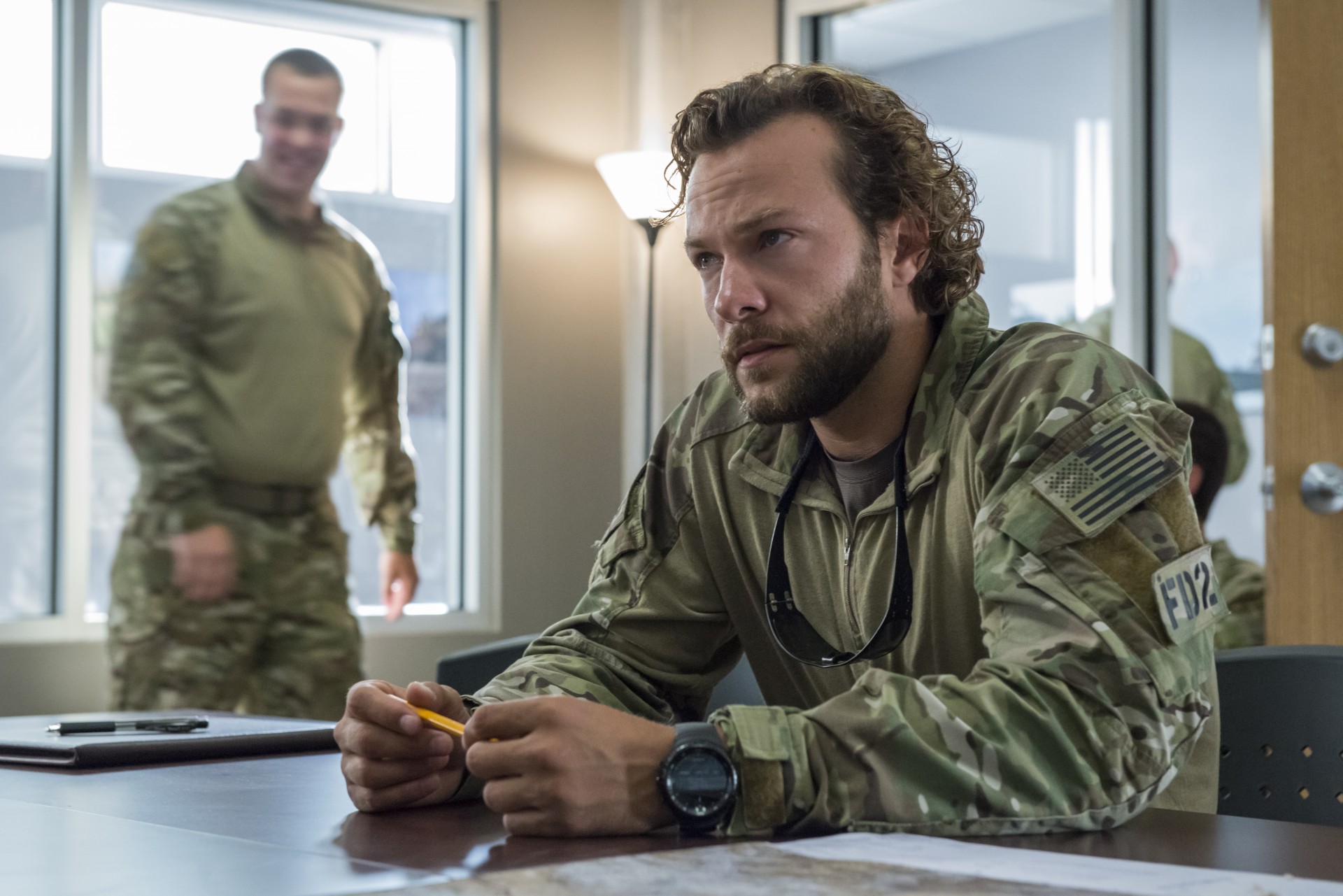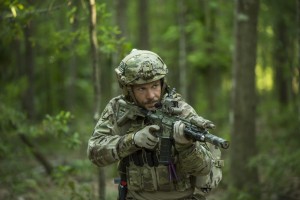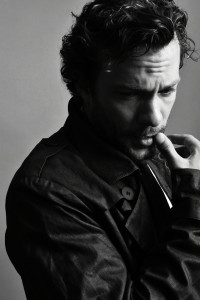
Kyle Schmid Landed The Role of a Lifetime on History’s SIX
With the runaway success of Vikings, History has doubled down on scripted drama. SIX, a new series inspired by the real-life missions of SEAL Team Six, stars Kyle Schmid and Walton Goggins and airs on Wednesday nights. Season One finds former team leader Rip Taggart (Goggins) captured by Boko Haram. The current members of SEAL Team Six, including Alex Caulder (Schmid) spring into action on a series of operations to rescue Taggart. The action is fast, brutal, and realistic and the storyline zips along at a torrid pace. It’s been so well-received, History has already renewed the series for Season Two while Season One is still in progress.
You might remember Schmid from his roles on Copper and Being Human, but you’ve never seen him like this. Schmid and the cast of SIX underwent rigorous physical and tactical training so that their portrayal of the America’s most elite warriors would be realistic. Schmid recently sat down with RI Magazine to talk about the experience.
BY MATT TUTHILL
Robert Irvine Magazine: The training for SIX wasn’t just weight training, but tactical and weapons training. How long did it take you to get ready to play a SEAL and what was the first step?
Kyle Schmid: The first step was we worked with a group called SealFit (a training program developed by former Navy SEAL commander Mark Divine). Their priority was to basically break us down mentally and physically to the point where you have a better understanding of what your limitations are. And once you’re aware of limitations are, aware of how far you can actually take your body and what you can endure, it gives you a much better understanding of and respect for what we’re truly capable of. That’s something that the SEALs do to create these ultimate warriors.
Obviously, we only touched the tip of the iceberg with that training, but it gives us a much better understanding of why these men are so fearless and courageous and why they’re capable of the things they can do. Then you go through the weapons training and the tactical training and that gave us the ability to move and think like these men. Then it’s finding the characters. When you work with a group of actors as good as these guys are on the show, throughout the training, we slowly developed into our characters innately, organically. Those bonds, those relationships you see in the show, it’s very similar to what we have in our real lives. This all took place 3-4 weeks before shooting. By the time we got down to North Carolina, we were pretty much just walking and talking as our characters for the 5-6 months we were working.
RI: Your character, does he have a real-life analogue or is he an amalgam of different people?
KS: He’s an amalgam of different people. He was a product of his upbringing and someone who didn’t have a father figure and was in a very unstable and possibly abusive household as a child and someone who had to become independent and responsible for himself at a young age. He developed this sense of loneliness or abandonment at that young age until he met his high school sweetheart. He got her pregnant at an unfortunate and early time in his life. And he decided to go out and join the SEALs and at BUD/S (Basic Underwater Demolition/SEAL training) he finally found a purpose also, more importantly, a father figure in Rip, who is played by Walt Goggins. That’s a relationship we’ll explore more in-depth. It allows the audience to make their own moral and ethical choices and put themselves in the shoes of those characters and see how they’d be able to react.
Caulder is a warrior, he’s broken for other reasons inside. He’s quick with a joke and the way I like to describe him is there’s a term in the industry called clowning. It’s like the sad clown, who’s always happy on the outside and quick with a joke and has that smile on his face. People think he’s never bothered by anything, but he has these dark secrets. Just below that surface there is a something boiling all the time. He’s constantly at odds with trying to protect the people around him and make sure they’re first. I think that will eventually have a price on him, mentally or physically.
RI: I’m familiar with SealFit. You said it helped you mentally get into the SEAL headspace. What about physically? What can you do now that you couldn’t do before?
KS: There’s a fact that Coach Divine threw at us during training: when the average person thinks they’re exhausted, they’ve only done 40% of what their body can handle. That was kind of an eye opener. And we learned that the hard way. We dealt with a little bit of sleep deprivation, some water torture ideas… All of these things created a very strong sense of brotherhood. When I go to the gym now and after an hour I think I’m tired, I know I’m not. When I feel like my muscles are at their limit, I can still do another six reps. Physically, I know what I’m capable of. When I’m scared I know that if I sit in my three-foot world and concentrate on the things that are in my control and ignore the things that are out of my control, that I can focus and collect and make a better decision. All of those things are important life lessons that I am able to apply to my daily life all the time and it made me a stronger person. It made my relationships stronger at home as well.
RI: You carry 60 pounds of gear on your body while you film. Why not fake it at least half time? A lot of special ops guys have joint and mobility issues later in life because they carry all that gear.
KS: I don’t think it’s fair to try and represent a group of men like that, and do it properly, without putting ourselves in similar scenarios. The gear gives you the ability to walk and feel so much. It changes the way you move. There’s a confidence to the way you move when you know you’ve got a 20-pound plate on your chest and a 20-pound plate on your back and if someone does shoot you in the back, that if you create a small enough target, that the chances are you’ll live.
The weapons are a necessity. All of those things are a necessity to try and create a show that would hopefully open the minds of the public to understand what these men do for a living and what they sacrifice. Hopefully it creates a better understanding of how and why they should be helping veterans when they get home from 10, 15, or 20 years of service and they’re struggling to find purpose or an idea of how to fill that void that they’ve just given so much of their life to. We put a lot on the line and it took a big toll on us over five and a half months, both mentally and physically, but you know what? It’s nothing compared to what these guys go through on a regular basis in real life. It’s a small sacrifice for us but we’re just trying to do the best we can to represent the real heroes in this world who don’t get the respect they deserve sometimes.
RI: What did you bring to the table that helped create the character, from your own life experiences?
KS: I knew very little about the military. I’m Canadian by birth though I’ve lived down here for a number of years. But I don’t think that changes anything. Fighting for your loved ones doesn’t have any limitations by culture. I was an athlete growing up and I played on many different teams and had brotherhoods that I valued very much growing up. My parents were divorced. I had a little bit of the idea of what it might be like for Caulder at times when he felt alone here and there. The idea of solace in independence, I felt that over the course of my life many times, where it’s so much more comfortable to be alone and to have your brotherhood on the side, which is what Caulder does now. He’s also a fun guy and he kind of runs away from his problems to an extent. He loves to have a good time and hang out with the boys and kick back with a beer and we as a cast did a lot of that in North Carolina because our families were either out in Los Angeles or in other countries. So that brotherhood naturally developed. I luckily had a cool house that I rented and we had many barbecues with fires and s’mores and good whiskey. It was fun.
RI: Did you have to do anything different nutrition wise, to get ready for the show?
KS: I’m naturally about 155 pounds, which is what I was when I got the show. Within two months I was 175. That came from nutrition, from eating six square meals a day. We had an amazing craft services team that kept us fueled and ready to go. When you are carrying around that equipment all day, you burn calories so quickly. I was able to gain that weight for the show which helped so much with the character. These guys aren’t light guys. I ate all the time. I ate breakfast for two at 5:30 and again at 8:00 and again at 11:00, and then protein shakes.
In Hollywood movies, they tend to glamorize the military as six-pack 210-pound beasts who look like they could go be professional wrestlers. These guys are not that. They are your neighbors you see walking their dogs. They are guys you see pumping gas. There was no need for us to try to have six packs. We were not trying to glamorize the idea of these people. We were trying to tell as honest a story as we could.
RI: You’ve been acting for over 20 years, been in several hit shows and you’re now starring in a hit drama. Acting is incredibly tough business to get into but you made it. What advice would you have for someone out there who’s dreaming big?
KS: Persevere. Keep the faith. Never give up. Take help when you can, give help when you can. But ultimately, just never give up. I’ve gone through years of my life just hoping and dying for jobs in this business and I refused to go home or walk away because I just wasn’t built that way. If you’re going to give up, you’re going to fail. That’s a guarantee. But if you never give up, you never know what’s around the next corner. Life’s a funny thing that way.



